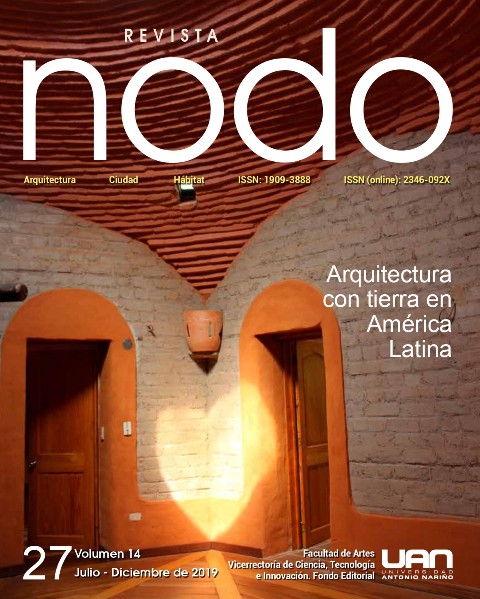Earthen plasters stabilized with prickly pear cactus
DOI:
https://doi.org/10.54104/nodo.v14n27.167Keywords:
sustainability, traditional construction, plasters, binder, mucilageAbstract
Earthen architecture coatings fulfill with several functions such as protection of the structures, regularization of surfaces to make them more hygienic (for not having gaps in which microflora or fauna inhabit) and the water vapor exchange with the surrounding air. This article presents the advances of a research that studies the possible improvement of mud plasters from the recovery of regional traditions derived from the use of the mucilage of the cactus known in Mexico as “nopal” (Opuntia spp.). Results currently found show a remarkable increase in plasticity and adherence of mixtures, a slowdown in the drying time which improves the uniformity of surfaces, a saving of water for mixing and a delay near to 300% on moisture absorption.
Downloads
References
ASTM C-39 (2006). Standardized test method for resistance to compression of cylindrical concrete specimens. USA: ASTM International
Cruz, S. (2013). El mucílago de nopal como aditivo de las pastas de cal empleadas en conservación. En Barba, L. y Villaseñor, I. (Eds.). La cal: Historia, propiedades y usos. México: IIA-UNAM y ANFACAL, A.C., pp.183-202.
Garzón, L. y Neves, C. (2007). Investigar, formar, capacitar, transferir. Los grandes desafios de la arquitectura y construcción con tierra. Apuntes, 20 (2): pp.324-335.
Guerrero, L. (2014). La sostenibilidad de la vivienda tradicional. Revista de Arquitectura, Universidad Católica de Colombia, Colombia, pp.126-133.
Guerrero, L.; Correia, M. y Guillaud, H. (2012). Conservación del patrimonio arqueológico construido con tierra en Iberoamérica. Apuntes 25 (2): pp. 210-225.
Guerrero, L. (2016). El papel de la humedad y la compactación en la elaboración de recubrimientos de tierra. construcción con tierra CT7, Junio, pp.11-22.
Kita, Y. y Daneels, A. (2015). Evaluación de bitumen como estabilizante para patrimonio construido en tierra bajo el clima trópico húmedo. Estudios sobre conservación, restauración y museografía. v. 2. ENCRyM-INAH. pp.129-144.
Lozano, A. (2008). La piel del edificio. Cali: Universidad del Valle.
Minke, G. (2005). Manual de construcción en tierra, Uruguay: Fin de Siglo.
NMX-C-036-ONNCCE (2004). Industria de la construcción–bloques, tabiques o ladrillos, tabicones y adoquines– resistencia a la compresión. Método de prueba. México: Organismo Nacional de Normalización y Certificación de la Construcción y la Edificación, S.C.
Noriega, M. (2015). Los nopales de México, catálogo visual. Revista Arqueología Méxicana, pp.48-53.
Normal 11/85 (1985). Assorbimento d’acqua per capillarità – Coeficiente di assorbimento capillare. Italia: CNR-ICR.
Pérez, N. (2009). Formulación de un mortero de inyección con mucílago de nopal para restauración de pintura mural. Tesis para obtener el Grado de Ingeniero Químico.Guadalajara, México: ITESO.
Pérez, A.; Guerrero, L.; González, J. y Prado, R. (2017). Nopal mucilage as hydration agent for quicklime; extraction methods, Ge-conservación, 11: pp. 189-195.
Torres, P.; Cruz, S.; Peña N.; Fernández M. E; Rodríguez, M.; Cruz, A. (2015). La baba y el mucílago de nopal, una alternativa natural para la conservación de acabados arquitectónicos de tierra. Revista Interdisciplinaria, INAH, 99: pp. 93-114.
Warren J. (1999). Conservation of earth structures. Oxford: Butterworth Heinemann.
Ramírez, S. y Arellanes, F. (2012). Propiedades de durabilidad en hormigón y análisis microestructural en pastas de cemento con adición de mucílago de nopal como aditivo natural. Materiales de Construcción, 62: pp. 307, 327-341.
Downloads
Published
-
Abstract711
-
PDF (Español)362
How to Cite
Issue
Section
License

This work is licensed under a Creative Commons Attribution-NonCommercial-ShareAlike 4.0 International License.




 Portal de Ciencia Abierta
Portal de Ciencia Abierta